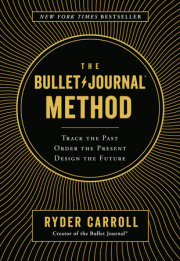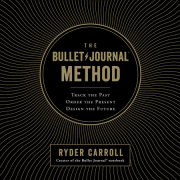The Promise
Life had gotten too busy. It seemed as if my
existence had become just one long to-do list.
I had forgotten about my dreams, my goals,
my what-ifs, my "what if I could's."
-Amy Haines
The Bullet Journal method's mission is to help us become mindful about how we spend our two most valuable resources in life: our time and our energy. If you're going to invest both reading this book, it's only fair to start by highlighting what's in it for you. To sum it up:
The Bullet Journal method will help you accomplish more by working on less. It helps
you identify and focus on what is meaningful
by stripping away what is meaningless.
How does it do this? By weaving together productivity, mindfulness, and intentionality into a framework that is flexible, forgiving, and, most importantly, practical. Let's take a closer look at each.
Productivity
Do you ever feel overwhelmed by all your responsibilities? Sometimes life feels like a hellish game of whack-a-mole, condemned to stomping out never-ending chores, meetings, emails, and texts. Your multitasking madness has you squeezing in workouts by pacing across your apartment while FaceTiming your sister-who is asking if you could breathe less heavily. Nothing is getting the attention it deserves, and it doesn't feel good. You hate disappointing other people as much as you hate disappointing yourself. To get more done, you've even hacked your sleep, whittling it down to the bare minimum-except now you're a zombie because . . . you've hacked your sleep down to the bare minimum.
Let's step back. Every year between 1950 and 2000, Americans increased their productivity about 1 to 4 percent. Since 2005, however, this growth has slowed in advanced economies, with a productivity decrease recorded in the United States in 2016. Maybe our rapidly evolving technology that promises us near-limitless options to keep us busy is not, in fact, making us more productive?
One possible explanation for our productivity slowdown is that we're paralyzed by information overload. As Daniel Levitin writes in The Organized Mind, information overload is worse for our focus than exhaustion or smoking marijuana.
It stands to reason, then, that to be more productive we need a way to stem the tide of digital distractions. Enter the Bullet Journal, an analog solution that provides the offline space needed to process, to think, and to focus. When you open your notebook, you automatically unplug. It momentarily pauses the influx of information so your mind can catch up. Things become less of a blur, and you can finally examine your life with greater clarity.
The Bullet Journal will help you declutter your packed mind so you can finally examine your thoughts from an objective distance.
We often cobble together ways to organize ourselves on the fly. A little of this app; a little of that calendar. Over time, this results in an unwieldy productivity Frankenstein of Post-its, various apps, and email. It kinda works, but it also feels like it's coming apart at the seams. You waste time deliberating where information should go and trying to locate it later: Did you write something down in your notes app or on a Post-it? And where did that Post-it go, anyway?
Many a great idea, "keeper" thought, or important "note to self" has fallen victim to a misplaced scrap of paper or an outdated app. It's a compounding inefficiency that drains your bandwidth, but it's completely avoidable. The Bullet Journal is designed to be your "source of truth." No, this is not some dubious invitation to worship this methodology. It means that you no longer have to wonder where your thoughts live.
Once you've learned how to keep your thoughts in one place, we'll examine how to prioritize them effectively. Everyone calling, emailing, or texting you wants your answer right away. Rather than being proactive about setting priorities, a lot of us simply let the flood of external demands set them for us. Distracted and overextended, our opportunities go under. There goes your chance to increase your GPA, to get that promotion, to run that marathon, to read a book every two weeks.
BuJo puts you at the helm. You'll learn how
to stop reacting and start responding.
You'll learn how to tackle difficult challenges and turn your vague curiosities into meaningful goals, how to break your goals into smaller, more manageable Sprints, and then finally how to effectively take action. What's the next step to improving your GPA this semester? Acing all your classes? No. Get more incremental. In which class are you falling behind? What's the next assignment in that class? Writing a paper. Okay, what book do you need to read before writing that paper? Getting that book from the library-that's the most important thing you have to do now. What about doing the extra-credit assignment for the class you're already acing? Waste of time.
In this book, we will introduce scientifically proven techniques that turn any notebook into a powerful tool for surfacing opportunities and weeding out distractions, so that you can focus your time and energy on what actually matters.
Mindfulness
Uh-oh, the "M" word. Don't worry, no sitars required. When we talk about mindfulness, we're typically talking about a heightened awareness of the present. Productivity is all fine and good, but BuJo isn't designed to help you spin faster on the hamster wheel.
We live in an age where technology promises us near-limitless options to occupy ourselves, yet we're left feeling more distracted and disconnected than ever before. Like when flying, we watch the world speed by at 600 miles an hour with no idea where we truly are. If we're lucky, we may glimpse some ocean glinting below or lightning ripping through dark distant clouds. For the most part, though, we're semiconscious passengers, killing time before the unnerving descent.
If the journey is the destination, then we must learn how to become better travelers. To become better travelers, we must first learn to orient ourselves. Where are you now? Do you want to be here? If not, why do you want to move on?
Knowing where you are begins
with knowing who you are.
Mindfulness is the process of waking up to see what's right in front of us. It helps you become more aware of where you are, who you are, and what you want. This is where BuJo comes into play. The act of writing by hand draws our mind into the present moment on a neurological level unlike any other capturing mechanism. It is in the present moment that we begin to know ourselves. Joan Didion, a famous proponent of writing things down, began doing so at age five. She believed that notebooks were one of the best antidotes for a distracted world: "We forget all too soon the things we thought we could never forget. We forget the loves and the betrayals alike, forget what we whispered and what we screamed, forget who we were. . . . It is a good idea, then, to keep in touch, and I suppose that keeping in touch is what notebooks are all about. And we are all on our own when it comes to keeping those lines open to ourselves: your notebook will never help me, nor mine you."
For you digital natives out there, fear not. Banish the image of some hunched, squint-eyed Dickensian figure endlessly scrawling away in a garret by failing candlelight. No, here you'll learn how to capture thoughts quickly and effectively. You'll learn how to journal at the speed of life.
This is where BuJo comes into play. We'll explore various techniques that help us form the habit of asking these kinds of questions, so we stop getting lost in the daily grind. In other words, the Bullet Journal method keeps us mindful of why we're doing what we're doing, so we make the most of our precious time and energy.
Intentionality
Think back to a book, a speech, or a quotation that deeply touched you or changed the way you thought about life. It was wisdom that inspired you, that held so much promise. All you had to do was act on this newfound knowledge and things would get easier, better, clearer, more empowering.
Now, how much of this knowledge is still in play-not just intellectually, but practically? Did you become a better person, friend, or mate? Did you keep the weight off? Are you happier? Chances are what you learned has withered, if it survived at all. It's not that it wasn't helpful. It just didn't stick. Why is that?
The rush of our busy lives can quietly carve out a gulf separating our actions from our beliefs. We tend to follow the path of least resistance, even when it leads away from the things we care about. It can require a lot of ongoing effort to effect the change we seek. As any athlete will tell you, you need to tear muscle to build it, over and over again. Like building muscle, we need to train our intentions to make them resilient and strong.
Whereas it's easy to "forget" to meditate or summon excuses to skip yoga, there are serious and immediate repercussions when we ignore our day-to-day obligations. To successfully introduce a new sustainable routine, it needs to fit into your packed schedule. What if you had a way that championed your intentions and kept you more organized throughout your day?
The Bullet Journal method acts as a bridge between your beliefs and your actions by integrating into the nitty-gritty of your life.
In addition to organizing her obligations, Amy Haines used her Bullet Journal to keep track of ideas for her business, people she wanted to learn from, apps to check out, even new teas to try. She customized her Collections-which you'll read about later-to cut through the sinking feeling of endless to-do lists and to stay in touch with what she really wanted to do. She was able to reclaim the things that mattered and had gotten away.
Through Bullet Journaling, you'll automatically form a regular habit of introspection, where you'll begin to define what's important, why it's important, and then figure out how to best pursue those things. You're gently reminded of these insights every day, which makes it easier to put them into action wherever you happen to be, be it a boardroom, classroom, or even emergency room.
Bullet Journalists have been hired for dream jobs, started businesses, ended toxic relationships, relocated, or, in some cases, simply become more content with who they are by making BuJo part of their routine. This methodology is powered by wisdom from traditions around the world. Like a reverse prism, Bullet Journal absorbs these traditions and focuses them into one bright beam that will help you clearly see where you are and illuminate the way forward. It will empower you to go from passenger to pilot through the art of intentional living.
the Guide
Bullet Journaling is not a fair-weather friend. It has dutifully suffered and celebrated alongside me through all the different seasons of my life. It has served the many masters of my former selves: the student, the intern, the heartbroken, the designer, and more. It always welcomes me without judgment or expectation. When setting out to write this book, I wanted to create something that could serve you the same way. This book is designed as your Bullet Journal base camp. It's here to prepare you for your first ascent and to welcome you back when you need to rest, restock, and recalibrate.
For Those Just Getting Started
If this is your first experience with the Bullet Journal, welcome! Thank you kindly for spending your time here. To get the most from this book, I encourage you to follow the linear path, beginning to end. This path is designed to be participatory. We'll leverage the power of transcription (page 49) to help you imprint the system faster into your mind. All you'll need is a blank sheet of paper, an empty notebook, and something to write with.
The Bullet Journal method is comprised of two main components: the system and the practice. Part II of this book will focus on the system. You'll learn the names of the ingredients and how they're used. Like in a kitchen, Parts I and II will help you become a skilled line cook. Parts III and IV are where we delve into the practice. There you'll learn how to become a chef. We'll explore the sources and science behind these ingredients so that you can customize the Bullet Journal to suit your needs.
For Seasoned Bullet Journalists-
and Anyone in Between
The chapters are designed as independent Collections (page 87), mimicking the structure of the Bullet Journal system. As long as you're comfortable with the BuJo vocabulary, you should be able to open the book to any chapter that grabs your attention. If you're not, then check out Part II!
Part II delves into the system that you know and love in great detail. We take a closer look at each core Collection and technique, revealing both the reasoning and history behind their design. Then, in Part IV, we apply all of these concepts to a mock project. Here you'll learn how to extend and further customize the system.
The system, however, is only one part of what makes up the Bullet Journal method.
The first parts of this book are about how
to Bullet Journal. The latter parts are
about why to Bullet Journal.
If you've been Bullet Journaling for a while, you may have felt there's more to it than just keeping your lists organized. You may feel that it's made you more grounded, confident, focused, calmer, even inspired. That's because the Bullet Journal is powered by various sciences and philosophies to help us live with more intention. In this book, I'll pull back the curtain to reveal why the Bullet Journal has the effect that it does. This deeper context will not only validate what you're already doing, but can take your BuJo practice to a whole new level.
Whatever level you're at, from BuJo newbie to pro, this book is a look into the heart of Bullet Journaling, where mindfulness meets productivity to help you design a life you want to live.
The Why
Intentional living is the art of making our own choices before others' choices make us.
-Richie Norton
My first start-up, Paintapic, was born in a closet filled with thousands of thimble-size pots of paint. The service allowed you to turn your photos into a custom paint-by-number kit, complete with a canvas, paints, and brushes. At the time, I also had a demanding full-time day job, so Paintapic was built entirely on nights and weekends.
Leadership had changed at my nine-to-five, and the new direction had pulled the plug on the creative projects that allowed me to enjoy my job. Over time, this new vision became so limiting that I no longer felt I was adding real value to the company. My potential impact on Paintapic, however, was limited only by the amount of time I was willing to invest. I poured it on. So I Old Yellered my social life for Paintapic's sake and got to work.
Copyright © 2018 by Ryder Carroll. All rights reserved. No part of this excerpt may be reproduced or reprinted without permission in writing from the publisher.







